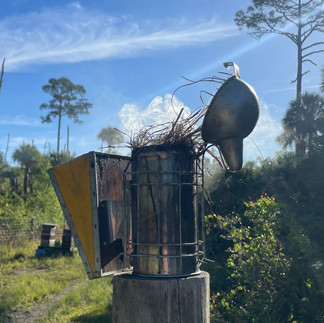Signs of Spring Up & Down the East Coast
- Angela Roell

- May 2, 2024
- 5 min read
Updated: Feb 18
I don’t measure Spring by the calendar dates, but instead by the shades of green as new blooms burst forth on the Atlantic Coast.
In Central Florida the first signs of Spring are the bursts of neon green live oak buds. Fleeting and abundant, their pollen kicks off the frenzy of Spring for us. Once they pop we launch into the queen catching and hive expansion that lasts until July in New England!
As we make our way down the coast to greet the live oaks, I notice red maple buds bursting forth in South Carolina. As we wind our way North again for a bee drop we follow the quaking burst of aspen flowers up the coast. In North Carolina we're greeted by the ephemeral greens of trillium and dandelion, and the deep purples of the Eastern Redbud. Our load of bees, who went to sleep in the swampy warmth of Central Florida, wake up in the windy hollers of North Carolina and plop down into the blooming dandelions for warmth.
Winding back down to Florida I notice the wisteria dripping in South Carolina, a few weeks earlier than last year. Looking down I see bursts of Dutch Clover globes popping up along the roadside. In the swamp again, I'm hit with the deep nectary scent of the swirling Saw Palmetto blooms, and the swelling buds of Eucalyptus trees.
More than any date on a Gregorian calendar, I measure time through all of these blossoms marking a different moment in Spring. Some mark the time for us to wind our way home to the Northeast. All of these are scents and sights woven into my world because they provide irreplaceable wild food sources for honeybees. All of these bursts of color and sweetness whisper "it's time to move bees". This time that move plunges us a little bit more into the unknown than before.
What's next? Where are we going? When are we coming home?
A beloved cacophony of questions meets us this year. Strangely, it makes me feel my roots in Florida more. I spent over a decade calling this swampy sweetheart home. Now the swamp romances us as we plot our transition to the mountains.
At the headwaters of the Everglades, I wander through live oaks and remember that they are as old as dinosaurs. While many of these ancestors were felled by colonizers hungry for tall ship hulls and fanciful furniture, their surviving daughter and granddaughter trees hold a story older than our time. Their understory winds with saw palmetto and palm, hums with pollinators and chirps with birds. The live oaks seem even more abundant, reaching out to brush up against my grief at leaving this incredible ecology.
Love the Everglades Movement advocates for the protection of the headwaters, estuaries and tributaries of this river of grass. You can read more about their work here.
Another day we paddle down the Rainbow River after swimming in the headwaters of the spring. It is so clear we can see small alligators, enormous turtles and every fish that flits underneath our canoe. As we paddle, warm sun and thick air kiss our skin. I've never seen water this clear anywhere else in the continental United States. This is a magic place being polluted by unregulated agricultural dumping, and fought for by the Florida Springs Council.
These folks are at the front lines of climate change, as Florida legislature erases the words "climate change" from legislative text. I can't help but feel a deep kinship with these liminal spaces between land and water. We're both undervalued as important ecologies. We both hold the line between the world of land and the world of water. We're both places where complexity of consciousness exists in ways many folks struggle to understand. Only one of us is on the verge of collapse though, and surprisingly it is not me, in spite of being quite weary. If you want to learn more about Florida, the ecojustice activists on the frontlines of change and how you can support this incredible place, check out our friend's film Can't Stop Change.
Meanwhile this move from Florida to North Carolina, this transition from one eco-region to another, is shaking my soul. The familiarity of Florida feels somehow comforting in spite of the complexity. I am realizing it isn't as simple as "pick up all the bees and go." There's a web of relationships here that hold us here. It took us several seasons to establish ourselves, and even longer to see a return on our investment. It took us almost four years to feel into the rhythms of migration in a sustainable way. At times it has taken more than I have to give, as I have adjusted to a life changing injury. The joys and grief of change mix together in a silty slurry still.
We are preparing to plunge into a new unknown as we expand into Western North Carolina. Yes we have beloved friends and collaborators there. We also have a steep ecological learning curve. We are confronted with different but similar challenges about development, environmental protections and social safety.

Will it work? Can we build the cooperative model we’ve been chipping away at since launching this project?
I'm not sure. There's always a risk. A risk to stay, a risk to go, a risk to balance on the precipice between the two. There's risk inherent in farming on the edge of climate catastrophe while watching your government prioritize war over care over and over.
I do know that for every doubt there is several humans doing deep care work, and and a collective of change makers working to shape the new world we're all breathing in. I know I'm proud to be in community & collaboration with many of those fine folks in our little corners of the world.
Slowly we will shift from one ecology to another. We'll hold tight to what makes us feel at home in Western Mass as we grow out from everywhere we get to lay roots.
But all things will happen in their time. Just like the swells, bursts and blooms of Spring we'll move at our own pace. We'll find our footing. We'll say our farewells, and weep as we need to so that the shift can be kissed by the salt of our tears. Just like the ecology, we'll make the changes we need to survive and perhaps, if the timing is fortuitous we will thrive.



















Comments